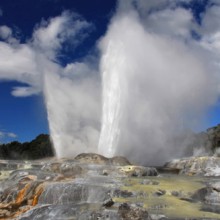Green Computing’s Final Four (of the week) Data Centers
Every week features many new green data center announcements, from their planning to their completion. This week, Green Computing Report is highlighting four (a Final Four, if you will, since it’s that time of year) initiatives and facilities that have piqued the interest of the green computing world. We start with Iceland-based Verne Global.
 Verne Global
Verne Global
Verne Global has come up before on Green Computing Report in discussing their lauded Icelandic data center. Indeed, GCR will be featuring Verne’s Chief Technological Officer Tate Cantrell next week for details on an award nomination as a result of said data center.
In the meantime, they also announced this week that they would be pushing their European efforts into Germany with the appointment of Andreas Sturm as director of business development. Sturm was formerly the regional managing director of the Germany, Austria, and Switzerland section of CommVault Systems and he hopes to bring that expertise to Verne Global.
“By using data centre facilities like Verne Global's,” Sturm said, “businesses in Germany are already able to make significant reductions in their carbon footprint, mitigating the impact that their energy-intensive IT operations have on the environment."
Environmental impact and energy efficiency are becoming bigger factors in the data center world, such that if all other variables (namely cost) are equal, an end user will choose the environmentally friendlier option more often than not. Verne Global hopes to extend their advantage in that respect to markets in Germany.
"Sturm's experience,” said Jeff Monroe, CEO at Verne Global, “will play an important role in explaining just how Verne Global can meet the data centre needs of DACH-based organisations, which face particular economic and political pressures to find more affordable, sustainable and predictable energy sources."
Gulf Air
Airlines have deceptively large computing needs, with logistics optimization and customer processing among the bigger drivers of airline computing.
Further, the green community is slowly turning their eye toward the Persian Gulf as Qatar plans on air conditioning their entire country for the 2022 World Cup. Gulf Air is trying to take the environmental initiative, building a new energy efficient data center.
The new facility reportedly uses blade technology to regulate and optimize airflow. "The new state-of-the-art, energy-efficient data centre has been redesigned with energy-efficient blade technology and virtualisation that cuts the power requirement by 50 percent and uses 30 percent less airflow, making it one of the most environment-friendly IT centres in the country," said Gulf Air director of information technology Dr Jassim Haji.
While the airflow designations are important, the virtualizing of servers could be paramount, as reportedly each server virtualized saves four tons of carbon dioxide emissions.
Gulf Air plans to use this data center to assist in determining other green measures, from big things like wireless communications to smaller-seeming objectives such as optimizing meal planning.
VYCON-Easy Street
We go from blades in the Persian Gulf to flywheels in Beaverton, Oregon. Specifically, VYCON has installed flywheels at the EasyStreet data centers in Oregon to serve as backup power generators.
"VYCON's flywheels continue to perform as expected," said Jon Crowhurst, director of technical services at EasyStreet. "Sustainability is a company priority; it's important that this data center operates with a zero carbon footprint. For us that means flywheels as our only source of power backup."
EasyStreet has reportedly ordered several VDC-XE flywheel systems to provide backup power to their Oregon data centers. Altogether, the flywheels can store 800 kW of clean, renewable energy.
This step is the latest that EasyStreet has taken in ensuring the green nature of their facilities. They recently completed a retrofit to their first center as well as having built a new Statement on Standards for Attestation Engagements (SSAE) 16 Type II data center.
As a result, the company is reportedly the first to attain funding from Oregon’s Department of Energy’s Small Scale Energy Loan Program (SELP). In all, through the flywheels, the retrofitting and the building of the new data center, the company is geared to save about 1500 megawatts a year.
Underground Data Centers
Finally, Hong Kong is looking into something quite unusual and possibly innovative with a new data center idea revealed at the Data Centre Space Asia conference in mid-March. That idea? Building the whole thing underground.
From an engineering standpoint, the idea will obviously be difficult to implement. However, such a data center would have a much easier time of regulating its temperature and keeping itself cool.
“It’s a great idea – as you know underground rock formations, caves, caverns etc. maintain an even all year round cool temperature,” said Amod Jayawant, director of critical environments at real estate services firm CBRE. “However, the technical side of this equation is not so pretty. It’s really a bunch of questions, the answers to which are sometimes not feasible or extremely expensive.”
Underground data centers aren’t exactly a new thing, as two exist in Green Mountain in Norway and Cavern Technologies in Kansas City. With that being said, the investment will still be significant, and may represent one of the cases where a green technology may not actually make financial sense.
Still, the environmental advantages, from being able to easier cull renewable geothermal energy to a more controlled environment for temperature regulation, would be significant. According to Hilary Cordell of the Cordells real estate law firm, plans have already been drawn up. Further, engineering consulting firm Arup has already conducted a feasibility study. A visual of the plans can be seen below.
These four designs and plans all do their part to advance the world of green computing and green IT as the demand for energy efficient data centers becomes more pronounced.
Related Articles
The Evolution of Green Data Center Optimization
Does Green Sacrifice Performance for Efficiency?
Groundwater Flows through New Datacenters











